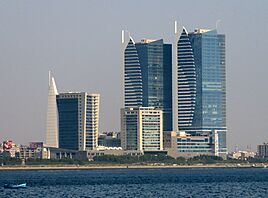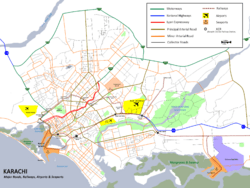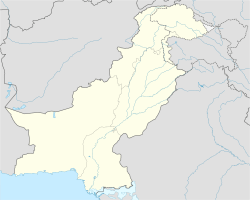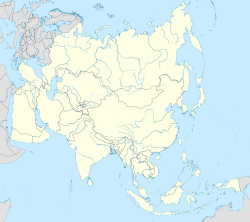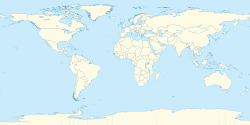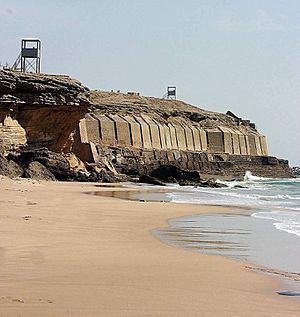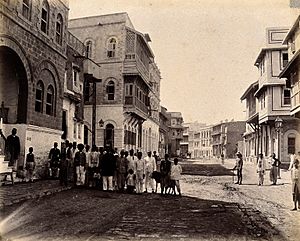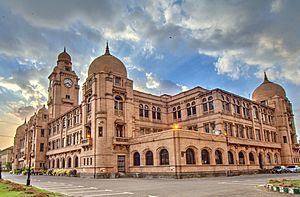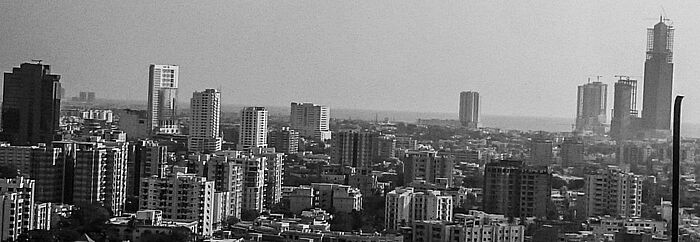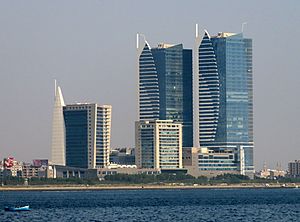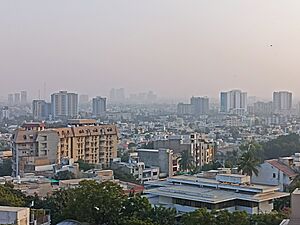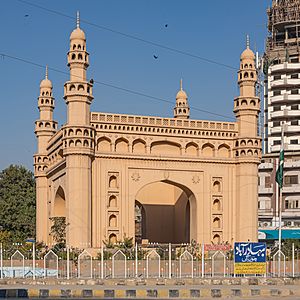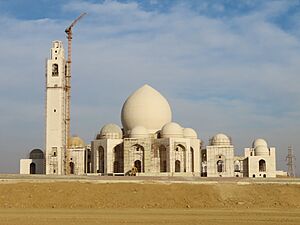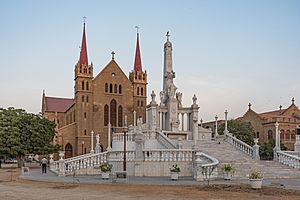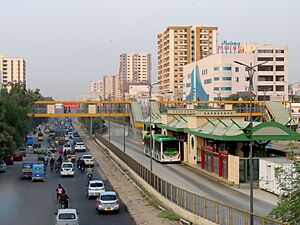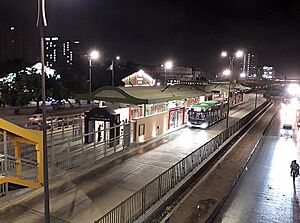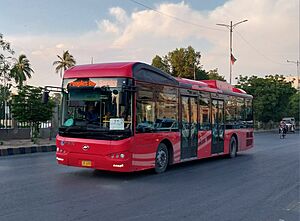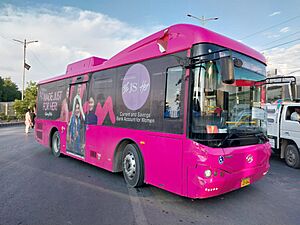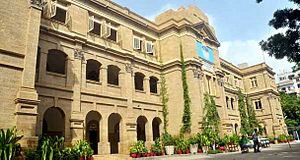Karachi facts for kids
Quick facts for kids
Karachi
|
||
|---|---|---|
|
|
||
|
||
| Nicknames: | ||
| Country | ||
| Province | ||
| Division | Karachi Division | |
| Settled | 1729 | |
| Metropolitan council | 1880 | |
| City council | City Complex, Gulshan-e-Iqbal Town | |
| Districts |
7
|
|
| Government | ||
| • Type | Metropolitan Corporation | |
| • Body | Government of Karachi | |
| Area | ||
| • Metro | 3,527 km2 (1,362 sq mi) | |
| Area rank | 1st | |
| Elevation | 10 m (30 ft) | |
| Population
(2023)
|
||
| • Megacity | 18,868,021 | |
| • Rank | 1st (Pakistan) 12th (world) |
|
| • Metro | 20,382,881 | |
| • Metro density | 5,779/km2 (14,970/sq mi) | |
| Demonym(s) | Karachiite | |
| Time zone | UTC+05:00 (PKT) | |
| Postal codes |
74XXX–75XXX
|
|
| Dialling code | 021 | |
| GDP/PPP | $200 billion (2021) | |
| International airport | Jinnah International (KHI) | |
| Rapid transit system | Karachi Breeze | |
| Largest district by area | Malir District (2,160 km2) | |
| Largest district by population (2023 census) | Karachi East (3,950,031) | |
| Densest district by population (2023 census) | Karachi Central (55,396/km2) | |
| Largest area by GDP (2020) | Saddar Town ($40 billion) | |
Karachi is a very important city in Pakistan. It is the capital of the Sindh province. Karachi is the largest city in Pakistan and one of the biggest cities in the world, with over 20 million people living there.
The city is located on the coast of the Arabian Sea in the southern part of Pakistan. It used to be the country's capital from 1947 to 1959. Karachi is a major center for business and industry in Pakistan. It is also known for being a very diverse city, with people from many different backgrounds, languages, and religions.
Karachi has been around for a very long time, but it officially started as a small village called Kolachi in 1729. It grew a lot when the British arrived in the 1800s. They built a big seaport and connected it to a railway network. After Pakistan became independent in 1947, many Muslim families from India moved to Karachi, and the city grew even faster.
Today, Karachi is Pakistan's main business and money hub. It brings in a lot of tax money for Pakistan and produces a big part of the country's total economy. Most big companies and banks in Pakistan have their main offices here. Karachi is also a major transport center with two large seaports and the busiest airport in Pakistan.
In the past, Karachi was known as the "City of Lights" because of its lively nightlife. However, it faced some tough times with conflict in the 1980s and 1990s. Luckily, things have improved a lot since 2013, and Karachi is now much safer.
Contents
The Name of Karachi
The city of Karachi was first known as Kolachi-jo-Goth in 1729. This name means "the village of Kolachi." It is said to be named after a woman named Mai Kolachi. Her son was believed to have bravely killed a man-eating crocodile in the village.
The name Karachee was first written in a Dutch report in 1742. This was a shorter version of the original name.
History of Karachi
Early Times
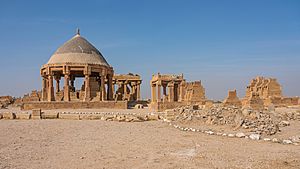
People have lived in the Karachi area for thousands of years. Scientists have found old tools from early hunter-gatherers in the hills nearby.
Ancient Greek writings might have mentioned this area. They might have called it Barbarikon, an old seaport near the Indus River. Some also think it was called Ramya.
A natural harbor called Krokola might have been near Karachi's Malir River. This is where Alexander the Great sailed his ships.
In 711 CE, Muhammad bin Qasim took over the Sindh and Indus Valley. He launched his forces from the port of Debal, which some believe was near Karachi.
Later, under the Mughal Empire, forts were built to protect the coast from Portuguese attacks. The Chaukhandi tombs in Karachi, which are old burial sites, were built around this time, between the 15th and 18th centuries.
The First Port and Settlement
The first port near Karachi was set up in the mid-1700s. It was called Kharak Bander.
A small group of huts called Dibro existed along the Karachi Harbour. In 1725, some Baloch people settled there after escaping droughts.
A new village, Kolachi-jo-Goth, was built in 1729. It was named after Mai Kolachi. This new village was about 40 hectares big and had cannons to protect it. A road was built to connect the port to trade routes. This road later became Muhammad Ali Jinnah Road.
In 1797, the Talpur rulers built the Manora Fort to protect Karachi's harbor from pirates.
British Rule
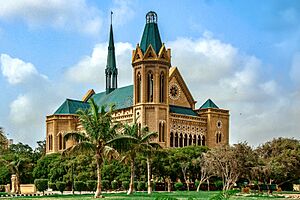
The British East India Company took over Karachi on February 3, 1839. They quickly destroyed the Manora Fort. At that time, Karachi had about 8,000 to 14,000 people.
The British built a military camp east of the city, which became the Karachi Cantonment. In 1840, Karachi became the capital of Sindh province.
The city grew a lot under British rule. In 1854, the British built the Port of Karachi. Karachi quickly became a major transport hub for British India. This was because of the new port and railway lines. By 1856, trade through Karachi was worth a lot of money.
Many people from different backgrounds moved to Karachi for work. These included British, Parsis, and Goan Christians. Muhammad Ali Jinnah, the founder of Pakistan, was born in Karachi in 1876.
Important buildings like Frere Hall (1865) and the Empress Market (1889) were built during this time. When the Suez Canal opened in 1869, Karachi's importance as a port grew even more. In 1878, Karachi was connected to India's vast railway system. By 1899, Karachi was the biggest wheat-exporting port in the East.
In 1936, Sindh became a separate province, and Karachi was again made its capital. By 1941, the city's population had grown to 387,000.
After Independence

When Pakistan became independent in 1947, Karachi was the largest city in Sindh. It had over 400,000 people. Karachi was chosen as the first capital of Pakistan.
Many Muslim refugees from India moved to Karachi. This greatly changed the city's population. By 1951, Muslims made up 96% of the city's population. The city's population tripled between 1941 and 1951.
Karachi was the capital of Pakistan until 1959. In the 1960s, Karachi was seen as a great example of economic growth. Many modern buildings were constructed, like the Mazar-e-Quaid and the Masjid e Tooba. The city's population grew very fast.
In the 1970s, more buildings were built, and apartment buildings became common. However, there were also labor problems. In the 1980s and 1990s, many refugees from Afghanistan came to Karachi. The city also faced political conflicts and an increase in crime.
However, after 2013, a special operation by the Pakistan Rangers helped reduce crime. Karachi became much safer. In 2022, Karachi was ranked 128th safest city for crime, much better than its 6th place in 2014.
Geography and Climate
Karachi's Location
Karachi is on the coast of Sindh province in southern Pakistan. It sits on a natural harbor along the Arabian Sea. The city is built on a flat coastal area with some rocky hills and marshlands.
There are mangrove forests in the salty waters around Karachi Harbour. West of the city is Cape Monze, which has sea cliffs and beaches.
Karachi is near a major fault line where two large land plates meet. However, it is on the edge of the Indian Plate. The city has two small hill ranges, the Khasa Hills and Mulri Hills. These hills are barren and are part of the larger Kirthar Range.
Karachi grew around the Malir River and Lyari River. The Lyari River shore was where the first settlement, Kolachi, was located.
Weather in Karachi
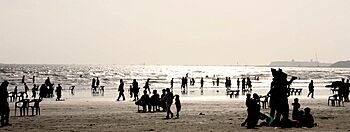
Karachi has a tropical climate. This means it has a long summer, but the Arabian Sea helps keep temperatures from getting too extreme.
The city gets about 296 mm of rain each year. Most of this rain falls during the monsoon season, from late June to September. Summers are hot and humid. Karachi can have dangerous heatwaves. However, cool sea breezes often provide relief.
The winter season is dry and pleasant, lasting from December to February. The hottest recorded temperature in Karachi was 48.0°C in April 2017. The lowest was 0°C in January 1934.
City Layout
Karachi first grew around its harbor. The Mithadar area shows how small Kolachi was before the British arrived.
British Karachi was split into "New Town" and "Old Town." The British mostly invested in the New Town. The Old Town was unplanned and lacked basic services. The New Town had homes, shops, and military areas.
Before Pakistan's independence, the city mostly developed north of the Chinna Creek. However, the seaside area of Clifton was also developed as a fancy neighborhood. These old areas have important buildings and monuments. I. I. Chundrigar Road is home to most of Pakistan's banks.
Today, Karachi has many different areas. Orangi is a large district northwest of the old city. Nazimabad and North Nazimabad are middle-class areas. Defence is a large, fancy suburb run by the Pakistan Army.
Karachi also includes several islands like Baba and Bhit Islands and Manora. Manora used to be an island but is now connected to the mainland by a thin strip of sand. Many areas like Gulistan-e-Johar and Gulshan-e-Iqbal were built after 1970. About 35% of Karachi's residents live in unplanned communities.
Karachi's Economy
Karachi is Pakistan's financial and business capital. It has been the center of the country's economy since Pakistan became independent. The city is the heart of a business area that stretches to nearby Hyderabad and Thatta.
In 2021, Karachi's economy was estimated to be worth $190 billion. It contributes 90% of Sindh province's economy and about 25% of Pakistan's total economy. Karachi collects 35% of Pakistan's tax money. It also produces about 30% of Pakistan's industrial goods.
Karachi's ports handle about 95% of Pakistan's foreign trade. Most multinational companies and all banks in Pakistan have their main offices in Karachi.
Money and Banking
Most of Pakistan's banks are located on Karachi's I. I. Chundrigar Road. This road is often called "Pakistan's Wall Street." Many major foreign companies in Pakistan have their main offices here.
Karachi is also home to the Pakistan Stock Exchange. This stock market was named Asia's best-performing stock market in 2015.
Media and Technology
Karachi has been a leader in cable TV in Pakistan. It has also seen a big growth in information technology and electronic media. The city has become a hub for software outsourcing in Pakistan.
Many TV and radio stations are based in Karachi. These include Geo TV, Express TV, and Dawn News.
Industries
Industry is a big part of Karachi's economy. The city has many large companies that make textiles, cement, steel, heavy machinery, chemicals, and food products. About 30% of Pakistan's manufacturing comes from Karachi.
Karachi has several large industrial areas like SITE, Korangi, and Bin Qasim. The Karachi Expo Centre also helps the city's economy by hosting big exhibitions.
People of Karachi
Karachi is a very diverse city. It has people from all over Pakistan and other parts of Asia. The city is known for having many different languages, ethnic groups, and religions.
In 2023, Karachi's population was about 20.3 million. It is one of the fastest-growing cities in the world. People who live in Karachi are called Karachiites.
Languages Spoken
Karachi has the largest number of Urdu speakers in Pakistan. According to the 2023 census, the main languages spoken in Karachi are:
- Urdu: 50.60%
- Pashto: 13.52%
- Sindhi: 11.12%
- Punjabi: 8.08%
- Balochi: 3.97%
- Saraiki: 3.70%
- Others: 9.01% (including languages like Kutchi, Gujarati, Memoni, Bengali, and more)
Population Growth
At the end of the 1800s, Karachi had about 105,000 people. By 1947, it had grown to 400,000. After Pakistan's independence, hundreds of thousands of Muslim refugees from India moved to Karachi. This caused the city's population to grow very quickly.
The city's population tripled between 1941 and 1951. Economic growth also attracted more people from all over Pakistan and South Asia. In 2017, Karachi's population was 14.9 million. By 2023, it reached 20.3 million.
Different Ethnic Groups
The oldest parts of Karachi still have many Baloch and Sindhi people. After Pakistan was created, many Hindus left, and many Muslim refugees from India settled in Karachi. These refugees, called Muhajirs, made up 57% of Karachi's population in 1951.
Karachi is now a "melting pot" of different cultures. It is Pakistan's most diverse city. In 2011, about 2.5 million foreign migrants lived in the city. They came mostly from Afghanistan, Bangladesh, Myanmar, and Sri Lanka.
Many of Karachi's citizens are descendants of Urdu-speaking migrants from North India. These Muhajirs make up almost 45% of the city's population.
During the 1960s, many Pashtuns from northern Pakistan moved to Karachi. Later, Afghan Pashtun refugees also settled here. Karachi now has the largest urban Pashtun population in the world.
People from Punjab also started moving to Karachi in the 1960s. They now make up about 14% of the population. Most of Karachi's Christian community is Punjabi.
Even though Karachi is the capital of Sindh province, only about 6-8% of the city's population is Sindhi. About 4% of Karachi's people speak Balochi.
After the 1971 war that created Bangladesh, many Urdu-speaking Biharis moved to Karachi. Many Bengalis also migrated from Bangladesh in the 1980s and 1990s. Karachi is now home to an estimated 2.5 to 3 million Bengalis. There are also about 400,000 Rohingya refugees from Myanmar.
Religions in Karachi

Karachi is mostly a Muslim city, with over 96% of its people following Islam. About 85% of Karachi's Muslims are Sunnis, and 15% are Shi'ites. There are over 3000 mosques in Karachi, including the famous Grand Jamia Mosque.
About 2.2% of Karachi's population is Christian. This community includes Punjabi Christians and Goan Catholics. Karachi has its own archdiocese, the Roman Catholic Archdiocese of Karachi.
Even though many Hindus left after Pakistan's independence, Karachi still has a large Hindu community. There are several active temples in central Karachi, like the Swaminarayan Temple.
Karachi also has a small community of Parsis. They have lived in the region for a long time.
Getting Around Karachi
Roads
Karachi has a large road network, about 15,500 km long. About 5 million vehicles use these roads every day.
The city has 6 special signal-free roads. These roads help traffic move quickly without stopping at lights. Examples include Karsaz Road and Shahrah-e-Faisal.
The Lyari Expressway is a 16 km highway that helps reduce traffic in the city. The Karachi Northern Bypass (M10) helps traffic go around the city. A new Malir Expressway is also being built.
Karachi is the end point of the M-9 motorway, which connects it to Hyderabad. From there, you can reach other major Pakistani cities like Peshawar and Lahore.
Trains
Karachi is connected to the rest of Pakistan by Pakistan Railways. The main train stations are Karachi City Station and Karachi Cantonment Railway Station. There is even an international train, the Thar Express, that connects Karachi to India.
The railway system also carries goods from Karachi port to northern Pakistan. The main railway line, Main Line-1, is being upgraded. This will allow trains to travel much faster.
Public Transport
Metrobus
The Pakistani Government is building the Karachi Metrobus project. This is a system of 6 bus lines that will cover 150 km. The Green Line and Orange Line are already working.
People's Bus Service
In 2022, the local government started the Peoples Bus Service. It has over 100 buses running on 12 different routes. The buses are air-conditioned and have Wi-Fi. Some buses are just for women (Pink buses), and some are electric (White buses).
Karachi Circular Railway
The Karachi Circular Railway (KCR) is a train system that serves the Karachi area. It was fully working from 1969 to 1999. In November 2020, parts of it started working again.
The KCR is being rebuilt as a modern, electric train system. It will connect the city center to many industrial, business, and residential areas. The new KCR is expected to be ready by 2025.
Tramway Service
Karachi used to have a tramway service that started in 1884 but closed in 1975. There are plans to bring back a modern tramway service in the future.
Air Travel
Karachi's Jinnah International Airport is the busiest airport in Pakistan. In 2018, it served 7.2 million passengers. The airport is a main hub for Pakistan International Airlines (PIA). It has flights to many places in Asia, Europe, and North America.
Sea Travel
Pakistan's largest shipping ports are the Port of Karachi and Port Qasim. The Port of Karachi is the oldest. These ports handle 95% of Pakistan's trade goods coming in and out of the country. They have modern facilities for handling containers and oil.
City Management
How Karachi is Governed
Karachi has a complex system of city government. The city is divided into six District Municipal Corporations (DMCs): Karachi East, Karachi West, Karachi Central, Karachi South, Malir, and Korangi. Each district is further divided into smaller Union Committees.
Karachi also has six military areas called cantonments. These are managed by the Pakistani military.
Important city services like water supply and building control are managed by the Government of Sindh. The Karachi Development Authority (KDA) plans new land development.
History of City Government
In 1846, the British set up the Karachi Conservancy Board to deal with a cholera outbreak. This board later became the Karachi Municipal Committee. In 1933, it became the Karachi Municipal Corporation.
In 1948, Karachi was made a special federal district. In 2001, all five districts of Karachi were combined into one city district. This system was changed back in 2011, and the city was again divided into District Municipal Corporations.
In 2013, a sixth district, Korangi, was created. In 2020, a seventh district, Kemari, was formed.
Each District Municipal Corporation manages land use, water supply, sewage, and local roads. They also handle street lighting and markets. The Karachi Metropolitan Corporation (KMC) is responsible for main roads, bridges, hospitals, and firefighting.
The current mayor of Karachi is Murtaza Wahab, who was elected in 2023.
City Services
Water Supply
The Karachi Water and Sewerage Board (KW&SB) manages the city's water supply. Most of the water comes from the Indus River and the Hub Dam. About 80% of homes in Karachi have piped water. Private water tankers supply water to other areas.
A big project called the K-IV water project is being built. It will bring 650 million gallons of water daily from Keenjhar Lake to Karachi. This will help solve water shortages in the city. There are also plans to build desalination plants on the coast to turn seawater into fresh water.
Sanitation
About 98% of Karachi's homes are connected to the public sewage system. However, most of the sewage is released without being treated. This causes water pollution.
In the Orangi area, residents worked together to build their own sewage system. This project, called the Orangi Pilot Project, has helped many people get access to toilets.
The Sindh Solid Waste Management Board (SSWMB) collects and disposes of trash. However, many residents report that their streets are not cleaned regularly.
Electricity
K-Electric is the main company that provides electricity in Karachi. Most of the city's electricity comes from power plants that use oil, gas, and coal. There are also nuclear power plants and wind power plants nearby.
About 75% of Karachi has electricity almost all the time. Some areas, especially industrial ones, still have power outages.
Emergency Services
The police in Karachi are managed by the provincial government. Ambulance services are run by private hospitals or charities like Edhi and Chhipa. The local government manages firefighting services, and they have enough firefighters and vehicles to respond quickly to fires.
Education in Karachi
Literacy Rates
According to the 2023 Census, Karachi Central has the highest literacy rate among all districts in Karachi and Sindh. Here are the literacy rates for people aged 10 and above in Karachi's districts:
- Central: 83.55%
- Korangi: 79.86%
- East: 80.07%
- South: 78.57%
- West: 67.43%
- Kemari: 62.07%
- Malir: 63.14%
Schools
Karachi's education system has primary, middle, high, and intermediate levels. After that, students can go to university. There are both public and private schools. Many schools are for one gender only, but universities are mostly for both boys and girls.
Some of Karachi's most famous schools, like St Patrick's High School, are run by Christian churches.
Universities and Colleges
Karachi has many important public universities. Some of the oldest ones, like Sindh Madressatul Islam (founded 1885) and D. J. Sindh Government Science College (founded 1887), were started during British rule.
The Nadirshaw Edulji Dinshaw University of Engineering and Technology (NED), founded in 1921, is Pakistan's oldest higher education institution. The Dow University of Health Sciences (1945) is a top medical research school.
The University of Karachi, founded in 1951, is Pakistan's largest university. The Institute of Business Administration (IBA), founded in 1955, is one of the oldest business schools outside North America and Europe.
Karachi also has many private universities. The Aga Khan University (1983) is a very respected medical school. Other notable universities include Hamdard University, National University of Computer and Emerging Sciences (NUCES-FAST), and Bahria University.
Healthcare
Karachi is a major center for medical research. It has at least 30 public hospitals, 80 private hospitals, and 12 medical colleges. Some well-known hospitals include Aga Khan University Hospital and Civil Hospital.
In 2017, Karachi started a new warning system for heatwaves. This system has helped prevent deaths during very hot weather. During the 2020-2021 COVID-19 pandemic, vaccines were available in all major hospitals.
Fun, Tourism, and Culture
Shopping Malls
Karachi is home to Lucky One Mall, one of the largest shopping malls in Pakistan and South Asia. It has over two hundred stores. Dolmen Mall in Clifton is also very popular. A new large mall, 'Mall of Karachi', is expected to open soon.
Museums and Galleries
-
The famous "Priest-King" statue of the Indus Valley civilization is displayed at Karachi's National Museum of Pakistan.
Karachi has many important museums. The National Museum of Pakistan and Mohatta Palace show off a rich collection of art. The city also has the Pakistan Airforce Museum, the Pakistan Maritime Museum, and the MagnifiScience Centre, which is an interactive science center.
Wazir Mansion, where Pakistan's founder Muhammad Ali Jinnah was born, is now a museum. His residence, Quaid-e-Azam House, is also a museum.
Theatre and Cinema
Karachi has important cultural places. The National Academy of Performing Arts offers courses in music and theater. Groups like Thespianz Theater work on performing arts activities.
Karachi is home to Urdu cinema. The Kara Film Festival shows independent Pakistani and international films. Popular cinemas in Karachi include Bambino Cinema and Nueplex Cinema.
Music
The All Pakistan Music Conference holds an annual music festival in Karachi. The National Arts Council also hosts musical performances.
Social Issues
Crime and Safety
Karachi was once known for high crime rates, but things have greatly improved. In 2014, it was ranked the 6th most dangerous city in the world. By 2022, it had dropped to 128th place, making it safer than many other cities.
The number of murders in Karachi has decreased a lot. In 2013, there were 3,251 killings, but this dropped to 381 in 2017. Crimes like kidnapping and extortion have also gone down significantly.
This improvement is thanks to a special operation started in 2013 by the Pakistan Rangers. As a result, real estate prices have gone up, and more people are enjoying restaurants and cafes.
Infrastructure Problems
Karachi's growth has been very fast, and city planning has not kept up. This means there are not enough good roads or public transport. Up to 1,000 new vehicles are added to the roads every day, causing traffic. Roads are often broken and not fixed quickly.
Pollution
Karachi has some of the worst air quality in the world. Dust from the desert, vehicles, and industries all contribute to air pollution. There is also a lot of noise pollution from traffic.
Land pollution is a problem because trash is not always properly disposed of. Water pollution is also an issue, as sewage and industrial wastewater often go directly into the Lyari River and Malir River without treatment. This pollutes the Arabian Sea and harms marine life.
City Flooding
The drainage system in Karachi is not big enough to handle heavy monsoon rains. Storm drains are often filled with trash. When it rains heavily in July and August, water floods streets, underpasses, and even homes. This causes problems for travel and can lead to deaths from drowning or electric shocks.
Architecture
Karachi has many different building styles. Downtown areas like Saddar and Clifton have buildings from the early 1900s. These include the KPT building and the Sindh High Court Building.
Some buildings, like Frere Hall and Empress Market, have a Gothic style. The Karachi Gymkhana has a Mock Tudor style. Many buildings show a mix of Indian and British architectural styles.
The Indus Valley School of Art and Architecture is a great example of saving old buildings. An entire building from the Kharadar area was moved to Clifton and rebuilt for the art school.
Karachi also has many modern and unique buildings. Examples include the Pakistan State Oil Headquarters and the Aga Khan University hospital. The I. I. Chundrigar Road has many tall buildings, like the Habib Bank Plaza and MCB Tower. Many new skyscrapers are being built in Clifton.
Sports
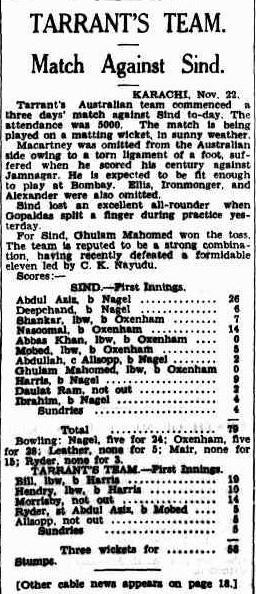
Cricket
Cricket has been played in Pakistan even before the country was formed in 1947. The first international cricket match in Karachi was in 1935, between Sindh and Australian teams. Karachi is also where "tape ball" cricket was invented, which is a safer and cheaper way to play.
The National Stadium has hosted many important cricket matches. The Pakistan national team has won many Test matches there. The stadium also hosted games during the 1996 Cricket World Cup.
A new stadium, Rafi Cricket Stadium, is being built in Bahria Town. It will be the largest cricket stadium in Pakistan, holding over 50,000 people.
Football
Lyari, a neighborhood in Karachi, is very important for football in Pakistan. It is often called "Little Brazil" because it has produced many talented football players.
Many players for the Pakistan national football team in the 1960s came from Lyari. The People's Football Stadium, one of the main football stadiums in the country, is located in Karachi.
Other Sports
Karachi has a special place in sports history. Some say that in 1877, the first rules for badminton were created in Karachi, possibly at Frere Hall.
Karachi has hosted the National Games of Pakistan seven times. The city also has golf clubs, and facilities for field hockey, boxing, squash, and polo.
Famous People
Sister Cities
See also
 In Spanish: Karachi para niños
In Spanish: Karachi para niños
- Subdivisions in Karachi
- Developments in Karachi
- Cinema in Karachi
- Cuisine of Karachi
- List of cemeteries in Karachi
- List of hospitals in Karachi
- List of magazines in Karachi
- List of newspapers in Karachi
- List of parks and gardens in Karachi
- List of people from Karachi
- List of streets of Karachi
- List of tallest buildings in Karachi
- List of tourist attractions in Karachi
- List of cultural heritage sites in Karachi
- List of television stations in Karachi
- List of Union Councils of Karachi
- Media in Karachi
- Sister cities of Karachi
- Transport in Karachi


